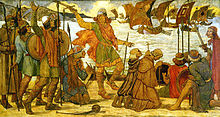Kingdom of Dublin
The Kingdom of Dublin was a sub-kingdom in Ireland founded by Vikings . It was independent from around 850 to 980, but Norwegian and Danish Vikings fought for supremacy in the 10th century . From 980 to the Anglo-Norman conquest in 1170, the Viking kingdom continued under the sovereignty of the Irish high kings, while the Vikings were gradually Gaelised.
history
First raids by Vikings on Ireland's coasts are documented from 795. Norwegian Vikings began to settle on the coasts by 820 at the latest, and Danish Vikings were added from 845. The Irish referred to the Scandinavian invaders as Finngaill ("white strangers", Norwegians ) and Dubgaill ("black strangers", Danes ). Turgesius , allegedly a Norwegian or Danish king's son, conquered the Gaelic coastal town of Dublin in 839 and expanded it into a fortified war and trading port in 841. He was killed fighting the Irish of Meath , who in turn conquered Dublin in 849. The defeated Norwegians were able to restore their rule, but were subject to the Danes in 851.
In 853 the Norwegians recaptured Dublin under Olov (Olaf) alias Analav (Amlaib), while Olov's brothers established lordships in Limerick and Waterford . After Olov's death his brother Ivar (Imar) took over the rule, but in 868 Limerick was lost to the Irish. Whether the two brothers were identical to Olaf the White and Ivar Ragnarsson is disputed. In rivalry with the Danes from the Anglo-Danish Kingdom of Jórvík (York), Ivar's successor ruled Dublin until the Irish conquered Leinster in 902. Waterford also fell to the Irish in the same year.
From Waterford, which was recaptured in 914, the Norwegians were able to recapture Dublin after the Battle of Confey in 917, but lost it again to the Danes under Sigtrygg (Sitric) and his successors Olaf Guthfrithsson and Olaf Cuaran , who also ruled York in the meantime. Instead, the Norwegians were able to recapture Limerick in 922, which henceforth rivaled Dublin before it was subjugated by the Dublin Danes in 937. In the Battle of Tara in 980 Dublin lost its independence to the Irish kings of Meath, whose sovereignty was finally shaken off in 1014 in the Battle of Clontarf .
Since Danish and Norwegian Vikings had mostly taken Irish women, there was a mixture of Norwegians and Irish, which was referred to as Iro-Norwegians . These Gaelic Norwegians ruled Dublin under Irish suzerainty until it was conquered by Norway's King Magnus III. (1102–1103) or until the final conquest by the Normans in 1170. An Irish-Norwegian attempt at reconquest under Ascall mac Ragnaill failed, and by 1174 Waterford, Limerick and Cork also fell to the Normans.
See also
literature
- Patrick F. Wallace: Dublin. In: Reallexikon der Germanischen Altertumskunde (RGA). 2nd Edition. Volume 6, Walter de Gruyter, Berlin / New York 1986, ISBN 3-11-010468-7 , pp. 215-224. (introductory article on the archeology of the Vikings in Dublin)
- Michael Richter : Ireland. Viking age. In: Reallexikon der Germanischen Altertumskunde (RGA). 2nd Edition. Volume 15, Walter de Gruyter, Berlin / New York 2000, ISBN 3-11-016649-6 , pp. 495-597. (on-line)
- Rudolf Simek : The Vikings . CH Beck, Munich 1998, pp. 25, 30ff and 52ff.
- Wolfgang Viereck, Katrin Viereck, Heinrich Ramisch: dtv-Atlas English language . Deutscher Taschenbuch Verlag, Munich 2002, pp. 52f and 60.
- Herrmann Julius Meyer (Ed.): Dublin . In: Meyers Konversations-Lexikon Volume 5. 3rd edition, Bibliographisches Institut, Leipzig 1875, p. 706.
- Herrmann Julius Meyer (Ed.): Ireland . In: Meyers Konversations-Lexikon Volume 9. 3rd edition, Bibliographisches Institut, Leipzig 1876, pp. 356f.
- Phillip Pulsiano, Kirsten Wolf: Medieval Scandinavia - An Encyclopedia , page 323f . Taylor & Francis, 1993
Web links
- Dublin Chronology , accessed November 1, 2014
- Isle of Man Chronology , accessed November 1, 2014
- Northumbria Chronology , accessed November 1, 2014
- The Penguin Historical Atlas of the Vikings: The Vikings in Ireland (The first Wave, 795-873)
- The Penguin Historical Atlas of the Vikings: The Vikings in Ireland (Conflict and assimilation, 874-1014)


